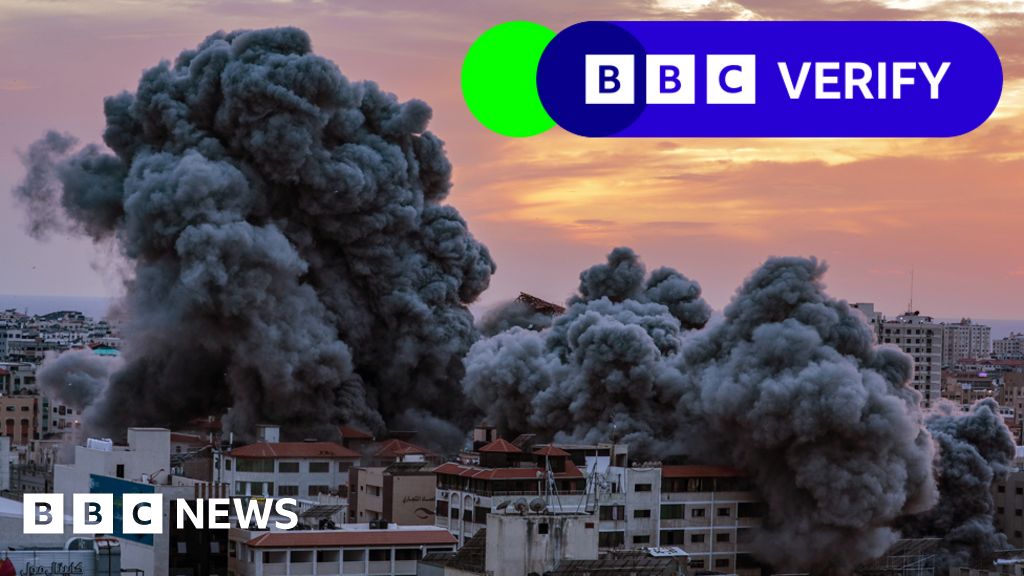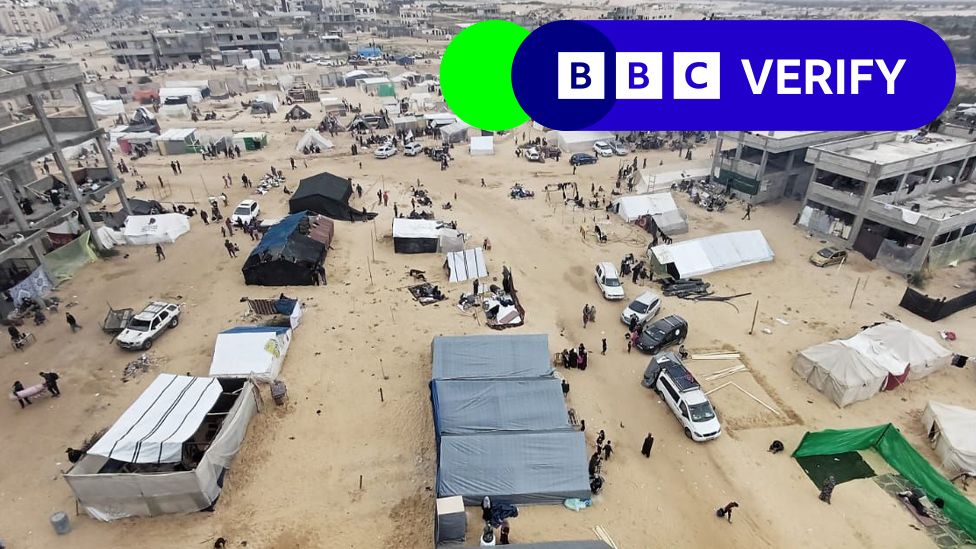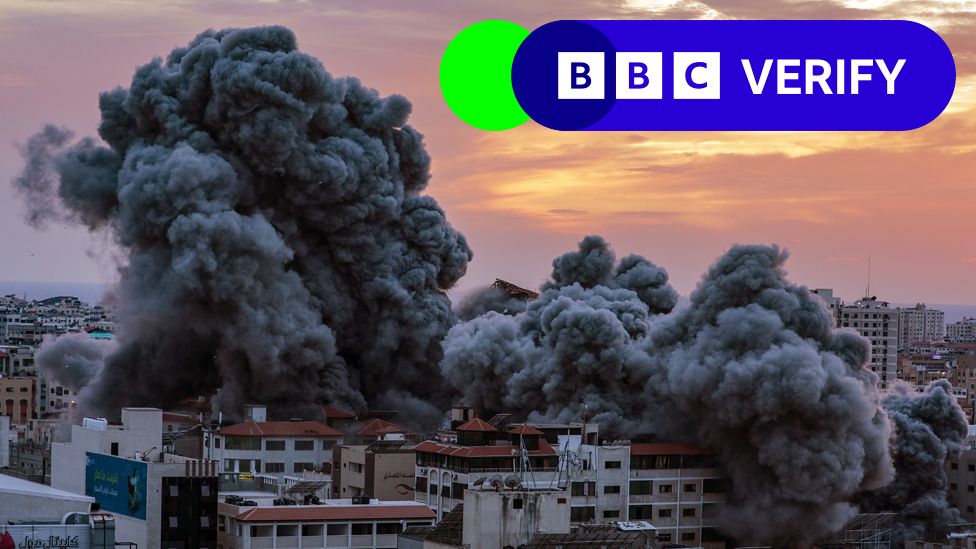
At least 20,000 Palestinians in Gaza have been reported killed since Israel began bombing the territory in the wake of Hamas’s 7 October attacks. BBC Verify examines what Gaza’s death toll reveals about the conflict.
On average, nearly 300 people have been killed each day since the start of the conflict, excluding the seven-day ceasefire, data from Gaza’s Hamas-run health ministry indicates. The World Health Organization’s regional emergency director Richard Brennan says he considers these casualty figures trustworthy.
Counting the dead is a challenge in any war zone, and doctors in Gaza say the death toll is likely to be significantly higher as it does not include bodies buried under the rubble of destroyed buildings or those not taken to hospitals.
BBC Verify has looked in detail at the figures, how they compare with other conflicts and the impact on Gaza’s young population.
A high death toll
The pace of killing in this war has been “exceptionally high”, says Prof Michael Spagat, who specialises in examining death tolls in conflicts around the world, such as the 2003 Iraq war, Colombia’s civil conflict, wars in the Democratic Republic of Congo as well as previous wars between Israel and Gaza.
“Within the series of Gaza wars stretching back to 2008, the current one is unprecedented both for the number of people killed and for the indiscriminateness of the killing,” he adds.

The 20,000 figure represents almost 1% of Gaza’s 2.2 million population.
The BBC has spoken to military experts who have described the wide variety of bombs used by Israel – some about 100lb and others as large as 2000lb – as having directly contributed to the scale of fatalities in this conflict.
Being near the impact of the largest bombs is like “surfing on the Earth as the shockwave momentarily liquefies the ground”, says Marc Garlasco, a former senior intelligence analyst at the Pentagon and former UN war crimes investigator, who spoke to victims and witnesses of these bombs.
What makes them even more devastating is that Gaza has a very high population density. It is just 41km (25 miles) long and 10km (six miles) wide. On average, before the conflict, there were more than 5,700 people per sq km in Gaza – very similar to the average density in London.
Israel began its military campaign in Gaza in the wake of Hamas’ attacks, in which 1,200 people were killed, most of them civilians. Three months later, it is facing mounting pressure over the number of civilian casualties.
In worldwide conflicts between 2011 and 2021, on average 90% of fatalities were civilians when explosive weapons were used on populated areas, according to the research and advocacy group Action on Armed Violence.
According to US intelligence assessments seen by CNN, in this war, Israel had dropped more than 29,000 bombs on Gaza since the war began and mid-December, with 40-45% of these unguided.
These unguided bombs “can miss their target by up to 30m, which is the difference between hitting a Hamas HQ and an apartment packed with civilians”, says Mr Garlasco, who has worked on three previous wars in Gaza and is now a military adviser for the Dutch peace organisation PAX.
The Israel Defense Forces (IDF) has said it takes precautionary measures in order to avoid damage to the civilian population.
It says these measures include warnings before strikes in cases where it is possible to do so. Israel has also insisted that its record on killing civilians has been better than those in other international conflicts.
The IDF says it will “abort attacks when we see unexpected civilian presence. We choose the right munition for each target – so it doesn’t cause unnecessary damage.”
Israel also says that Hamas uses Gaza’s civilian population as human shields.
How many civilians have been killed?
Women and children make up about 70% of those who have been killed in Gaza during the current conflict, says the Hamas-run health ministry.
However, Hamas’s figures do not distinguish between male civilians and combatants.
The previous official breakdown of the deaths from Hamas’s Government Media Office on 19 December, which stood at 19,667, said that more than 8,000 children and 6,200 women had been killed. It also said that 310 medical personnel, 35 civil defence personnel and 97 journalists had been killed – all of them civilians.
The war is having a particularly devastating impact on Gaza’s children. Nearly half of the territory’s population is under 18, according to data released in 2022 by the health ministry.
There have been over 52,000 people injured in the conflict so far, the health ministry says. While there are no up-to-date figures for the number of children injured, on 3 November there were reportedly 24,173 injured – comprising 8,067 children, 5,960 women and 10,146 men.
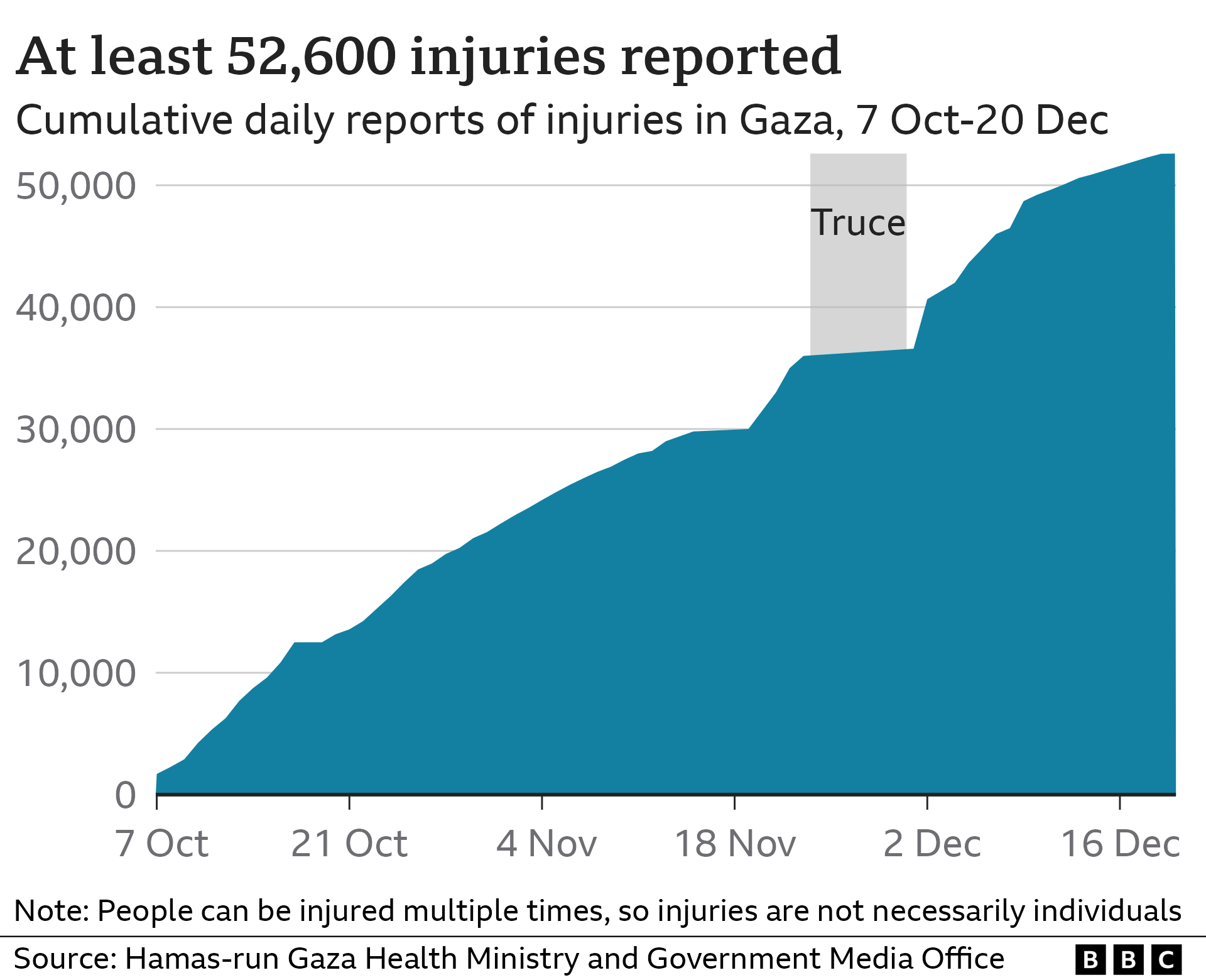
Gaza is now the “most dangerous place in the world to be a child”, according to the United Nation’s child agency, Unicef.
“Entire neighbourhoods, where children used to play and go to school, have been turned into stacks of rubble, with no life in them,” said Adele Khodr, Unicef’s regional director for the Middle East and North Africa.
How does this compare with other wars?
Each conflict is unique in the way it is fought, but the experts the BBC has spoken to agree that the rate of killing in Gaza is significantly bigger than in others fought recently.
“What we’re seeing in terms of civilian deaths has already far outpaced rates of harm from any given conflict we have documented,” said Emily Tripp, director of Airwars, an organisation which has monitored civilian deaths in wars and conflicts since 2014.
The former Pentagon intelligence analyst Marc Garlasco said: “To find a similar density of high explosives used in a small populated area, we might have to go back to the Vietnam war for a comparable example – like the 1972 Christmas bombing, when some 20,000 tons of bombs were dropped on Hanoi during Operation Linebacker II.” An estimated 1,600 Vietnamese civilians were killed in the Christmas bombings.
By contrast, US-led coalition air and artillery strikes killed fewer than 20 civilians per day, on average, during the four-month offensive to drive IS out of the Syrian city of Raqqa in 2017, according to Amnesty International. It is unclear how many civilians lived there at the time, but UN officials estimated that there were between 50,000 and 100,000. Additionally, over 160,000 civilians reportedly fled their homes and became internally displaced at the time.
And an Associated Press investigation suggested that between 9,000 and 11,000 civilians were killed in the nine-month battle between US-backed Iraqi forces and IS for the Iraqi city of Mosul which ended in 2017.
This amounts to an estimated fewer-than-40 civilian deaths per day, on average. Mosul had an estimated population of less than two million people when IS captured the city in 2014.
During the almost two years of the Ukraine war, the United Nations estimates that at least 10,000 civilians have been killed.
However, the UN’s human rights monitoring mission has also cautioned that the actual figure may be significantly higher given the challenges and time required for verification.
And comparing casualty rates in different conflicts is difficult, in part because varying methodologies are used for estimating deaths.
How many Hamas fighters have been killed?
Israel has stated its goal is to destroy Hamas but has not been clear how many of its members it has killed. Officials have previously pointed to “thousands” and elsewhere “7,000”.
Hamas is proscribed as a terrorist organisation by the Israeli and UK governments and others.
But when asked directly, the IDF said it “does not have an exact number on the number of Hamas terrorists killed”.
News agency AFP reported that senior Israeli officials had suggested Israel had killed two Palestinian civilians for every one Hamas fighter. That ratio was described by the IDF’s spokesman Jonathan Conricus as “tremendously positive”, to CNN.
The BBC has not been able to establish a clear method of verifying the number of fighters killed.
Prof Michael Spagat, said he would “not be at all surprised” if around 80% of those killed were civilians.
The IDF’s numbers for combatants killed “have been all over the place, devoid of details and without explanations”, he added.
There are “no reliable figures” for the ratio of civilians to combatants killed in Gaza, say Hamit Dardagan and John Sloboda of Iraq Body Count, an organisation that examines the number of deaths in the Iraq war.

More on Israel-Gaza war
- Follow live: Latest updates
- Gaza: How much damage has been done?
- History behind the story: The Israel-Palestinian conflict


Related Topics
-
-
16 November

-
-
-
1 December
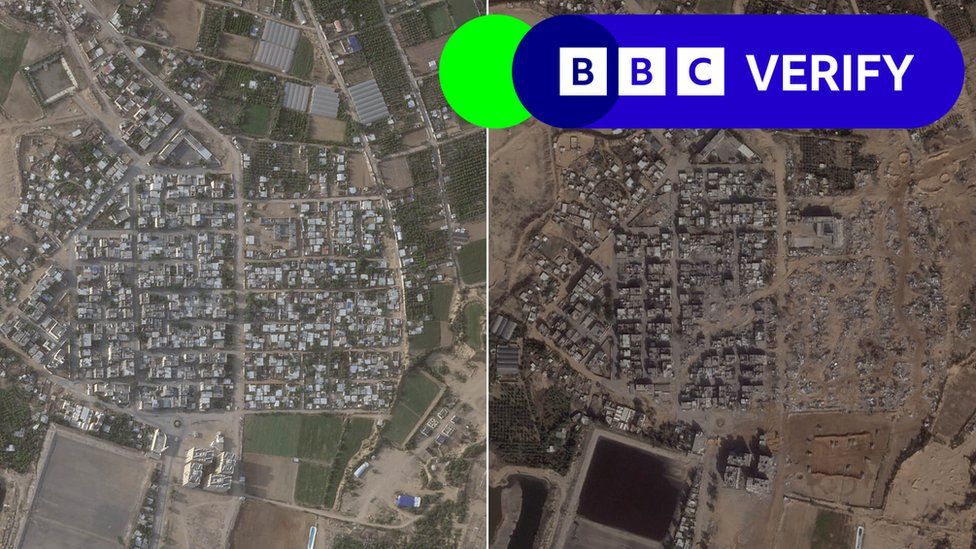
-
